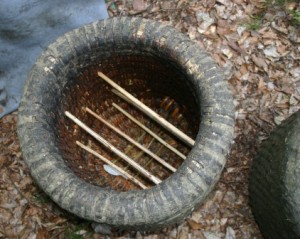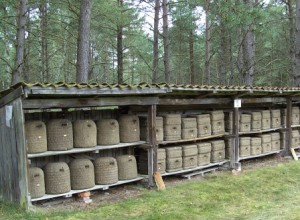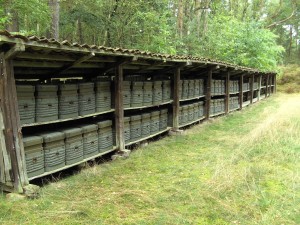All skeps are made of straw, that is bind together with cane (rattanpalm) or with splitted roots, sometimes also with splitted willow and splitted bramble.
I use mainly 3 types:

The old round skep, in my case the variaty of the Lüneburg Heath, with walls over 5 cm strong, and mainly coiled with splitted roots. Some of them are of the period before 1850, most of them are made between 1850 and 1930 except the ones I made.
The second type is the so called Kanitzskep, but it is in fact a modification, made by the beekeepers in the neighbourhood of Hermannsburg, that is some miles north of the beautiful town Celle in Germany in the Southern part of the Lüneburg Heath (that is nowaday mainly wood- and farmland)

This skep is rectangular, and when heather is blooming, it gets a super or honeybox, also made of straw, with wooden frames in which the bees can build fresh combs for combhoneyproduction.
This skep is made from the years 1925 til 1955. They are mainly coiled with cane. Here below you can see a video with some shots of a beekeeper in the fiftees of last century, that works with this type of skeps.
The third type is a skep that has frames, but is not invented to work in the way

modern beekeepers does, but for skepbeekeeping, that means beekeeping by natural swarming and inspection of the colonies by simple turning them over and view the combs from below. But in Autumn you can empty the skep by swiping the bees from the comb with a goose wing. Shaking still remains possible but is not necessary. Colonies that tend to swarm after the swarming period, can be “cured” by taking away some combs. So skepbeekeeping with some small advances( and some disadvances) of modern beekeeping.
The first two types of skeps are treated on the outside with a beautiful natural dark green paste that is produced by happy cows in the fields on lovely days in spring. This paste, after becoming dry, protects the skeps against rain and sun and makes them definitely more durable.
Besides these skeps, there are some special workingskeps, Dukeskeps and a Gravenhorst skep, thanks to Simon Swaerts.